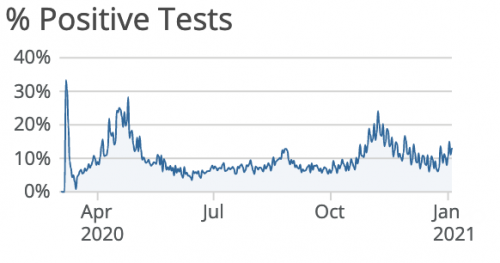I made my previous COVID-19 data in Iowa post at the end of August 2020. After spikes in March/April and June, the COVID-19 situation in Iowa had stabilized in August. However, there were some threats looming on the horizon. Primary among those were the upcoming re-openings of K-12 schools and colleges.
Let’s take a look at what happened after August.
COVID-19 in Iowa
Here’s the statewide data. Let’s focus on the period after August (roughly the midpoint of the graphic).


The short answer is that it was a roller coaster. We had a COVID spike in August and a much larger one in November. And then we had a steady decline in cases beginning around Thanksgiving. The data on positive test rates largely confirms the overall trend.
It’s not hard to figure out the major causes of the August spike: the re-opening of schools. Figuring out the major causes of the November spike is much more difficult. And, of course, did cases decline around Thanksgiving? I really don’t know. I suppose some have argued that they didn’t and the decline is a product of decreased testing. But that’s not well supported by the evidence. A decline in positive test rates also accompanied the decline in testing. That points clearly to the decline in cases causing the decline in testing – not vice-versa.
It could simply be that in August through November, COVID burned its way through all the communities where it was likeliest to spread. The remaining communities might be ones where people are taking much stronger precautions. In other words, Iowa’s quick spike followed by quick decline might simply be a standard consequence of not ‘flattening the curve‘ – there’s a sharp and deadly rise in cases, but it’s over relatively more quickly.
COVID-19 in Iowa City
The story in Johnson County largely mirrors that of the state as a whole. However, Iowa City – by far the largest city in Johnson County – has been under a mask mandate for months. As a result, numbers in Johnson County tend to be lower than the state as a whole. As a percentage of the population, we have far fewer COVID-19 cases than about two-thirds of the counties in the state.
The university’s decision to go online-only from Thanksgiving until late January also played a very positive role. However, with the Christmas holiday just past, a spike may loom.